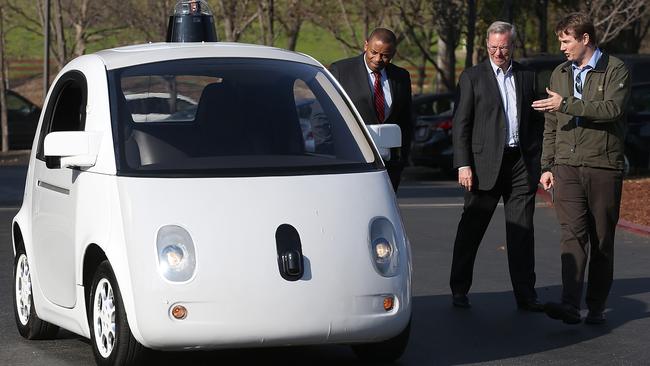Investing in the driverless car is an idea that will fly
THERE are barriers to adoption but they are not technological.

In the 1950s and 60s the car of the future was a flying car like the one piloted by George Jetson in the Hanna-Barbera cartoon series. Although flying cars have existed since the 50s, they never caught on and never will.
Today the car of the future is a self-driving or autonomous vehicle not unlike the Google Car. These vehicles and other self-driving variants (in many cases ordinary sedans and SUVs) are successfully and safely (under approved test conditions) navigating the freeways of California, Florida, Michigan and Nevada. In July last year, Britain announced a multi-million pound research fund to encourage driverless cars on the road. France has also approved testing on public roads.
Autonomous vehicles are coming, and I believe there are some investment opportunities that will capitalise on this theme.
Consider the benefits of an autonomous vehicle:
● A potentially significant reduction in road deaths (in 2010 the World Health Organisation reported that 1.24 million died in road accidents. That’s one person killed every 25 seconds)
● Lower CO2 emissions and fuel consumption
● Less congestion on the roads and more efficient roadway use
● Freedom for occupants to do other tasks both productive (work) and nonproductive (watch a video)
● Individuals prevented from driving through physical impairment or age gain mobility
● Freedom from the frustrations of other (human) bad drivers!
The McKinsey Global Institute, in its landmark 2013 publication “Disruptive Technologies: Advances that will transform life, business, and the global economy” predicts that the widespread adoption of self-driving vehicles would have a profound economic impact over the next decade, creating about $200 billion to $1.9 trillion a year of economic value.
Nonetheless, barriers exist to prevent widespread adoption of autonomous vehicles but they are not technological. Advances in machine vision and sensors are already well advanced and many existing cars already have “driver assist” features such as self-parking, lane changing, and accident avoidance via what are termed in the industry “advanced driver assistance systems” or ADAS.
For the most part, the barriers to acceptance are the establishment of a regulatory framework and sensor-laden road systems that can accommodate self-driving vehicles. This will take time (as it will involve governments not the private sector) but it is not a permanent impediment.
Other issues will also have to be tackled such as “driver” liability, the security of autonomous systems (cars being “hacked” and weaponised), software sophistication and reliability, the reluctance of drivers to give up control, and the additional costs involved in creating self-driving cars.
So assuming autonomous and semi-autonomous vehicles are on the way, where are the investment opportunities?
The key enabling technology for autonomous vehicles is called “machine vision” whereby cameras and sensors relay information to a computer that can recognise the surrounding objects. The development of 3D cameras, pattern recognition software, sophisticated sensors, LIDAR (laser-image detection), and GPS/mapping technology have made the self-driving vehicle possible.
A pure play in machine vision and advanced driver assistance technology (ADAS) is Mobileye NV.
Mobileye is an Israeli company, headquartered in The Netherlands and trades on NASDAQ in the US under the symbol MBLY. Mobileye NV has developed leading-edge automated driver-assistance technologies. Its monocular vision platform helps drivers improve safety, avoid accidents, and revolutionises the way individuals drive. The company’s products contain proprietary software algorithms bundled on its revolutionary EyeQ system-on-chip (or IC) and are integrated into vehicle electronic and control systems.
Mounted at eye level, these systems recognise signage, roadway features, other vehicles, and of course objects such as cyclists, pedestrians and road hazards.
The company’s first clients were automotive manufacturers such as BMW, General Motors and Volvo, whose electronics suppliers integrated Mobileye’s technology into their cars, first as an optional accessory, and later as a standard fit in some new cars.
Mobileye’s strategy is centred on the use of monocular cameras but is about to introduce a “tri-focal” system as cars evolve from semi to fully autonomous and need perfect recognition of all objects on the road.
Mobileye has a market capitalisation of $US7.7bn ($10bn) and currently has an 80 per cent market share of what may be the most powerful trend to hit the automotive industry. Analysts estimate revenues will increase from $US140 million in 2014 to $US1.6bn by 2020.
Another company to consider is Delphi Automotive PLC, a larger company with a $US22bn market capitalisation that trades under the symbol DLPH on the NYSE. While not a pure play in autonomous vehicles, Delphi is a leading manufacturer of electronic components for cars via its electronic/electric architecture (E/EA) division, specialising in safety and fuel economy products. It also supplies powertrains and heating/cooling systems to the global auto industry.
Delphi is no stranger to innovation — it invented the first electric starter in 1911, the in-dash car radio in 1936, and introduced the first integrated radio-navigation system in 1994.
The company has recently developed (along with partner Ottomatika — a spin-off from Carnegie Mellon autonomous vehicle research program) a “drop in” fully autonomous driving system with Delphi providing the sensors, radar and other “smart” components and Ottomatika the software algorithms. These systems have already been installed and successfully tested in an Audi SQ5 and at the recent CES Exhibition were shown installed in a Tesla and Fiat 500.
Delphi has announced $US3bn of bookings so far this year related to autonomous driving and has guided to “active safety” revenues growing at a 30 per cent compound annual growth rate over the medium term. Delphi is modestly valued, trading at 13.5x 2015 EPS, considerably below its estimated 5-year earnings CAGR of 15-17 per cent.
By some estimates this will be a $US17bn-$US29bn addressable market by 2020 (compared to $US6bn market today), driven by greater consumer awareness of driving assistance technologies, legislation mandating devices such as rear-vision cameras and automatic emergency braking, and the gradual adoption of autonomous and semi-autonomous driving.


